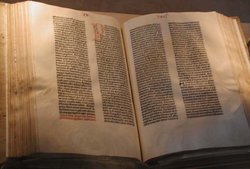Johann Gutenberg
|
|
Johannes Gensfleisch zur Laden zum Gutenberg (circa 1398 – February 3, 1468), a German metal-worker and inventor, achieved fame for his contributions to the technology of printing during the 1450s, including a type metal alloy and oil-based inks, a mould for casting type accurately, and a new kind of printing press based on presses used in wine-making. Tradition credits him with inventing movable type in Europe, an improvement on the block printing already in use there. By combining these elements into a production system, he allowed for the rapid printing of written materials and an information explosion in Renaissance Europe.
Gutenberg was born in the German city of Mainz, as the son of a merchant named Friele Gensfleisch zur Laden, who adopted the surname "zum Gutenberg" after the name of the neighborhood into which the family had moved.
| Contents |
Printing
Block printing, whereby as individual sheets of paper were pressed into wooden blocks with the text and illustrations carved in, was in use in Europe and East Asia long before Gutenberg. The Koreans and Chinese knew about movable metal types at the time, but due to the complex nature of the Chinese writing system, printed material was not as abundant as that of Renaissance Europe.
It is not clear whether Gutenberg knew of these existing techniques or invented them independently. Some also claim Dutchman Laurens Coster as the first European to invent movable type.
Reproduction of Gutenberg-era Press on display at the Printing History Museum in Lyon, France.Gutenberg certainly introduced efficient methods into book production, leading to a boom in the production of texts in Europe, in large part due to the popularity of the Gutenberg Bibles, the first mass-produced work, starting on February 23, 1455. Gutenberg was a poor businessman, and made little money from his printing system. At that time, the benefits of printing provided no real income, and as a result Gutenberg was forced to support himself printing sacramental indulgence documents for the Catholic Church. Gutenberg began experimenting with metal typography after he had moved from his native town of Mainz (Germany) to Strassburg (then a part of Germany, now in France and called Strasbourg) around 1430. Knowing that wood-block type involved a great deal of time and expense to reproduce because it had to be hand-carved, Gutenberg concluded that metal type could be reproduced much more quickly once a single mould had been fashioned. His first efforts enabled him to mass-produce indulgences, printed slips of paper sold by the Catholic Church to remit the temporal punishments in Purgatory for sins committed in this life.
Johann Fust
Bible
At the 1455 Frankfurt Book Fair, Gutenberg demonstrated the power of the printing press by selling copies of a two-volume Bible (Biblia Sacra) for 300 florins each. This was the equivalent of approximately three years' wages for an average clerk, but it was significantly cheaper than a handwritten Bible, which could take a single monk 20 years to transcribe.
The one copy of the Biblia Sacra dated 1455 went to Paris and was dated by the binder.
Subscriptions for most of the copies of the Biblia Sacra were probably already purchased before the printing was completed, so it is doubtful that any copies were ever sold at the Frankfurt Book Fair.
Debt
The money Gutenberg earned at the fair was not enough to pay Fust back for his investments. Fust sued, and the court's ruling not only effectively bankrupted Gutenberg, it awarded control of the type used in his Bible, plus much of the printing equipment, to Fust. So, while Gutenberg ran a print shop until just before his death in Mainz in 1468, Fust became the first printer to publish a book with his name on it.
Gutenberg was subsidized by the Archbishop of Mainz until his death. Gutenberg was also known to spend what little money he had on alcohol, so the Archbishop arranged for him to be paid in food and lodging, instead of coin.
Legacy
Although Gutenberg was unsuccessful in his lifetime, his invention spread quickly, and news and books began to travel across Europe far faster than before. It fed the growing Renaissance, and since it greatly facilitated scientific publishing, was a major factor in originating the scientific revolution. Literacy also increased as a result. Gutenberg's inventions are sometimes considered the turning point from the Mediaeval Era to the Early Modern Period.
Other printed works
The Bible was not Gutenberg's first printed work, for he produced approximately two dozen editions of Ars Minor, a portion of Aelius Donatus's schoolbook on Latin grammar, the first edition of which is believed to have been printed between 1451 and 1452.
Gutenberg Bibles
The Gutenberg Bibles surviving today are sometimes called the oldest surviving books printed with movable type, although the oldest surviving book is published in Korea in 1377. As of 2003, the Gutenberg Bible census includes 11 complete copies on vellum, 1 copy of the New Testament only on vellum, 48 substantially complete integral copies on paper, with another divided copy on paper.
The term incunabulum refers to a western printed book produced between the first work of Gutenberg and the end of the year 1500.
There are many statues of Gutenberg in Germany, one of the more famous being a work by Thorvaldsen, in Mainz, which is also home to the Gutenberg Museum.
The Gutenberg Galaxy and Project Gutenberg commemorate Gutenberg's name.


